Over the years I have tried to explain (to non-Pennsylvanians) exactly what I meant by a shoo-fly pie – and usually failed since everyone seems to cotton onto the word fly. Immediately it is relegated to the yuck category and they stop listening. Yet, I cannot blame them since I had the same initial reaction to “fly cemetery” as described by my husband – that peculiar Scottish fruit slice embedded with currants (AKA flies).
So, before you reach that yuck moment, let me explain that this particular pie does not contain flies, but (unlike that Scottish slice) no currants either. Its name came about this way: in the 19th century, “shoo-fly” was a common American interjection that entered the vocabulary from a popular minstrel song. Just as it implies, it was used to scare away pests, often accompanied with the flapping of hands.
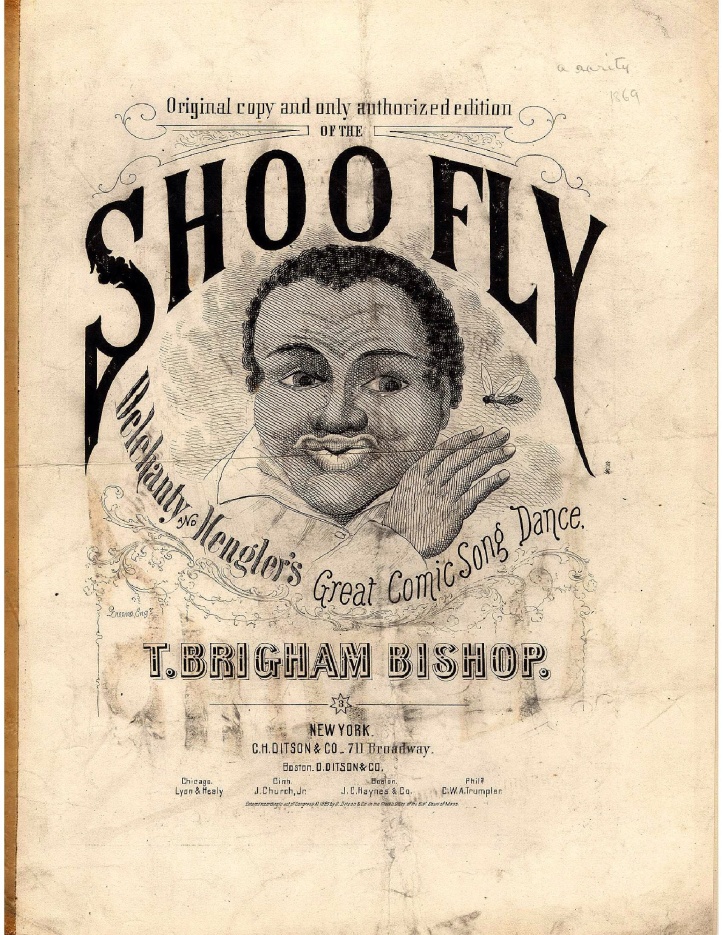 Cover of the 1869 sheet music publication of the song, “Shoo Fly,” also known as “Shoo Fly, Don’t Bother Me” by T. Brigham Bishop. From Wikipedia Commons.
Cover of the 1869 sheet music publication of the song, “Shoo Fly,” also known as “Shoo Fly, Don’t Bother Me” by T. Brigham Bishop. From Wikipedia Commons.
In the 1930s the name was applied to a particular Pennsylvania Dutch molasses-based pie whose sticky sweetness was known to attract flies while it was cooling. Although some sources on the culinary history of this pie indicate that the name is based on the corruption of the French chou-fleur, referring to resemblance of the pie’s crumble topping to a cauliflower. However, it seems more plausible to me that the name had been derived from the popular song. Or, this might be my personal bias against anything to do with cauliflower!
The pie itself is an oddity as it exhibits multiple personalities – a cake, a crumble and a pie. It can be eaten for breakfast, as an afternoon teatime treat or an after dinner dessert. To be as precise as possible, it is a crumble topped molasses cake – almost Yorkshire Parkin-like – set in a pastry crust. Even more confusing, there are two variations: a wet-bottom and a dry-bottom shoo-fly pie. This refers to the presence or absence of a layer of gooey molasses “custard” sandwiched between the crust and the cake-crumble part of the pie.
Pennsylvania Dutch Shoo-Fly Pie
This pie brings back all sorts of memories of my childhood. My favourite variation is the wet-bottomed one, but below are instructions for both the dry- and wet-bottomed varieties.
Shortcrust
I have substituted butter for what would undoubtedly have been lard in the original shortcrust pastry – a fat ingredient that many Pennsylvania Dutch recipes rely on. I have also followed Richard Bertinet’s method for making the shortcrust pastry as I am a convert to this way of producing a lovely flakey crust.
- 125g sweet unsalted butter
- 250g plain (all purpose) flour
- 1 teaspoon salt
- 1 egg
- 35g (or millilitres) water
Make sure that you butter is very cold, straight from the refrigerator. Place the block of butter between two pieces of greaseproof paper and bash it with a rolling pin until it is a flattened block, approximately 5mm thick. Return it it the refrigerator while you prepare the other ingredients.
Measure your flour and salt in a large bowl; mix. Have the egg and water to hand. Take the flattened butter from the refrigerator, peel away the paper and cover it with the flour. With your hands, rip the butter into several large pieces.
Then using both hands, flick the butter and flour between your thumbs and fingers until the butter pieces are about as small as your fingernail. DO NOT OVERWORK!
Add the egg and the water to the pastry and mix with a spoon. A silicon one works well here. Once mixed, use your thumbs to press the dough down, turning it over so that all the loose elements in the bottom of the bowl are combined into the dough.
Tip out onto a work surface and continue pressing down and folding the dough until it looks uniform in texture. Form into a block and wrap in greaseproof paper. Place in the refrigerator for at least an hour to rest. It can be left overnight if you want to make the dough ahead of time.
When you are ready to make the pie, preheat the oven to 190 degrees C (375 degrees F).
Meanwhile, roll out the pie dough to fit a 23cm (9 inch) diameter pie dish. Cut the dough to overhang the edges, then fold these under and crimp the edges. With a fork, prick holes in the base and sides of the crust. Place this back into the refrigerator while you get the filling ready.
Filling
I have added spice to the crumble mix and an egg in the molasses, ingredients lacking in the authentic Pennsylvania Dutch version I grew up with which.
Crumble Top
- 155g (1-1/4 cups) plain (all purpose) flour
- 60g (1/4 cup) butter
- 100g (1/2 cup) light brown sugar
- 1 teaspoon ground cinnamon
- 1/2 teaspoon ground ginger
- 1/4 teaspoon grated nutmeg
First make the crumble topping by placing all the ingredients into a bowl. Using a pastry cutter or your hands, work the butter into the dry mixture. Set this aside. It will be quite floury.
Molasses Custard
- 180ml (3/4 cup) molasses
- 180ml (3/4 cup) warm water
- 1 teaspoon baking soda
- 1 egg
Dissolve the baking soda in the warm water, then add the molasses. Stir to mix. Beat in the egg.
To Assemble & Bake:
Wet-bottom: for a bottom layer of molasses custard, pour 1/3 of the molasses custard into the pie shell. Fold 2/3 of the crumble into the remaining molasses mixture and add this to the pie shell, then top with the remaining crumble.
Dry-bottom: to produce a more uniform cake-like texture, reserve 1/3 of the crumble, mix the rest with the molasses mixture before folding it into the pie shell, then top with the reserved crumble.
Bake for 10 minutes at the preheated temperature, then reduce to 170 degrees C (approximately 350 degrees F) and continue baking for 30 to 35 minutes. Remove from oven and allow it to completely cool before cutting.
WARNING: Must like molasses!

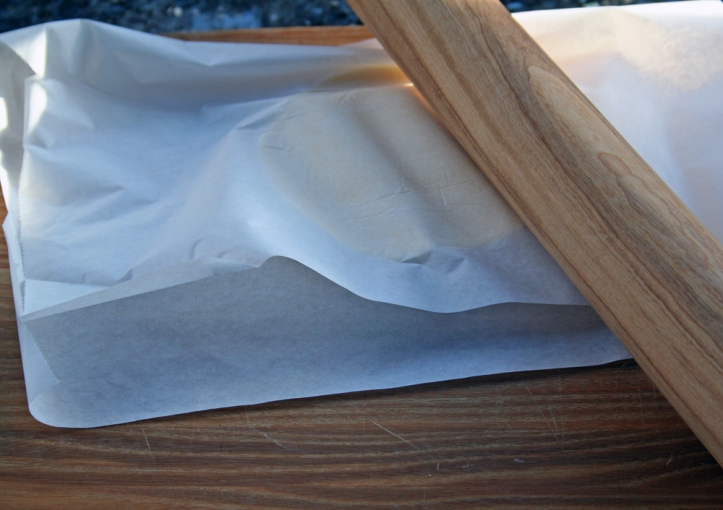




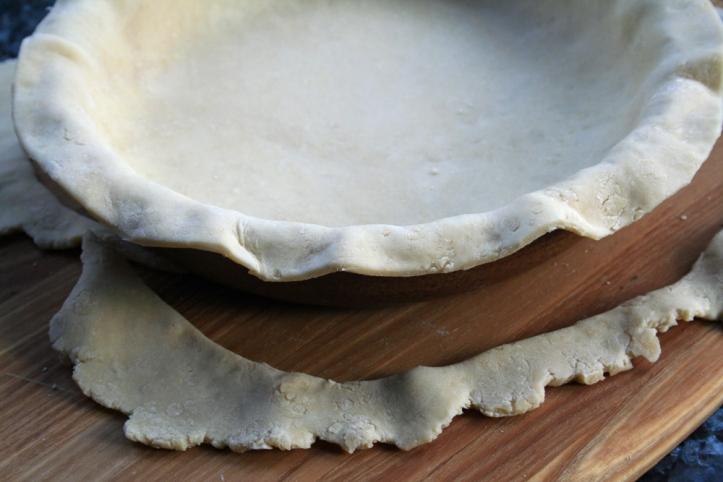
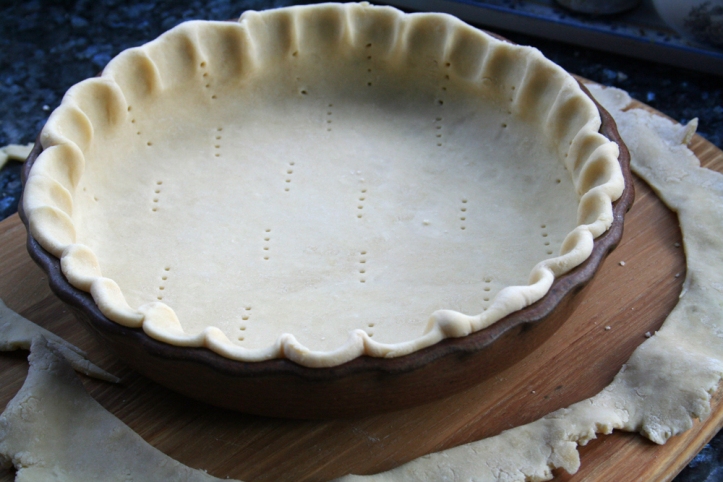
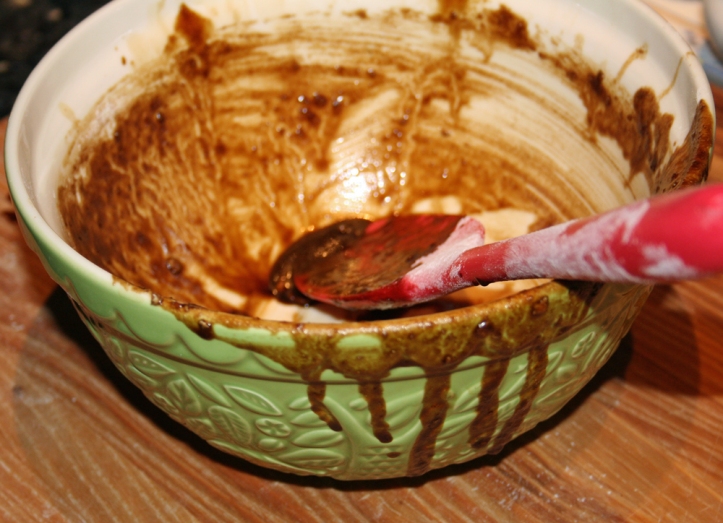
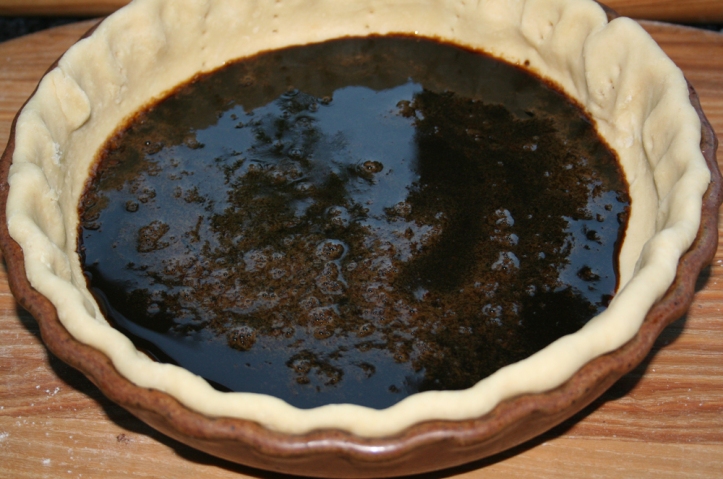

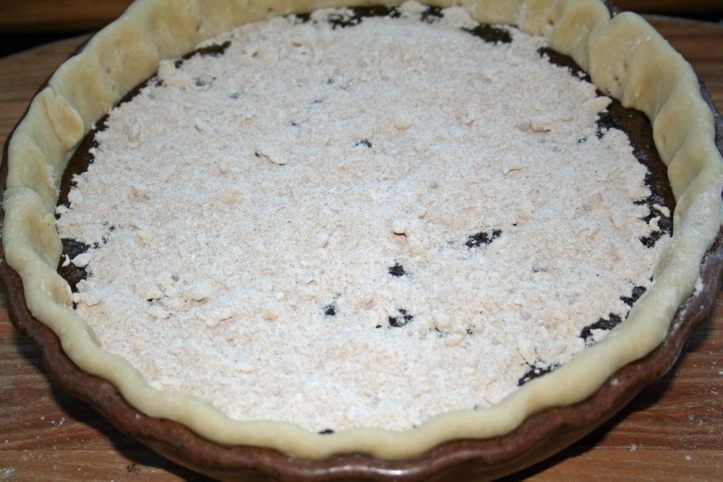
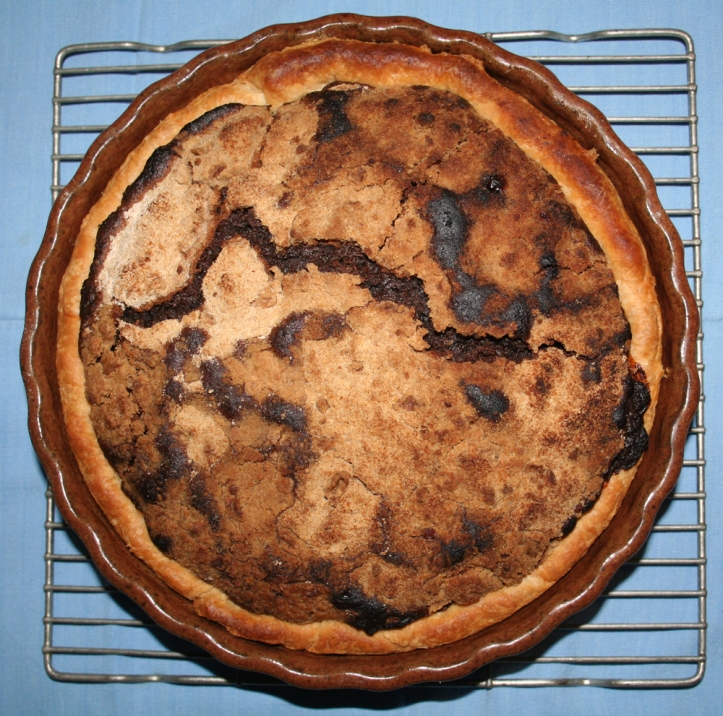
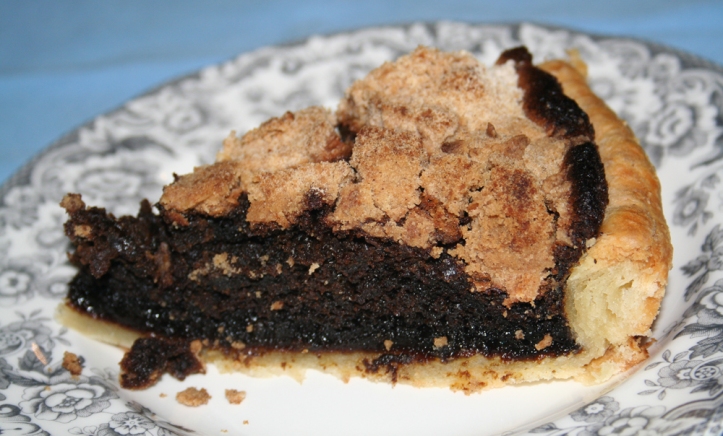
I think this is the first pie recipe I’ve seen properly depicting the varying stages of pie crust making. Hat tip to you!
LikeLike
All thanks to Richard Bertinet’s wonderful and well illustrated tutorial in his book, Pastry. Am now a convert to this method of making my shortcrust.
LikeLike
Ooooh, this looks incredible! I have heard of shoo-fly pie, but I had no idea what it was; I can imagine it attracts not only flies, but also numerous humans. Yum!
LikeLike
Flies, humans…they can all be pests at times. The pie is something I grew up with and had no idea it was an unfamiliar food for many.
LikeLike
Where do I start? Firstly I have fond memories of fly cemetries!! Ask your husband what he calls vanilla custard slices, we have a disgusting schoolyard name that has stuck. Secondly I have eaten and really enjoyed Amish dry bottom shoo fly pie in Holmes county Ohio, it was very sweet, but I’m a molasses fan, so loved it. I make rough puff in my mixer by the almost exact same method. It’s reliable, delicious and buttery. Great post Debi, now I’m thinking about molasses and parkin and gingercake…..
LikeLiked by 1 person
Wet Nelly. He claims they even called it that in the Yorkshire village “patisserie” where he grew up. It is also the term for a particular Liverpudlian bread pudding. But, try as I might, I cannot find anything rude about the etymology of that term. Except perhaps it being used to describe a weak or timorous person. Nelly on its own is short for Nelly Duff which is cockney rhyming slang for “puff” so it is possible that derogatory meanings can be derived from that. The Amish, whose main settlements are in Lancaster County in Pennsylvania (same as Pennsylvania Dutch), also make shoo-fly pie. They have carried the tradition with them to Ohio where there is a large population of Amish, but also as far west as Wisconsin where they have also established roots. The version my grandmother made was not sickeningly sweet although I have had awfully sweet versions before. I think it is a general characteristic of many traditional American cakes and pies.
LikeLiked by 1 person
Well sit down. We called them snot blocks. How gross is that? Along with fly cemetries, they are classics. The Scottish/Yorkshire name is far more subtle.
LikeLiked by 2 people
Unlike the Queen, we are amused! Will pass on your schoolyard term. He collects such things ( terms, that is!).
LikeLiked by 1 person
Glad you could see the funny side! Typical English/Aussie style cakes have all but disappeared and with them, a slice of social history. I recently taught my grand daughters some skipping games from my childhood, they were quite impressed, especially by the chants. i hope they went back to school after the summer holidays and started a new/old craze.
LikeLiked by 2 people
I found this really interesting. Thanks!
LikeLike
I have always wanted to know want a ‘shoo fly pie’ was in greater detail KW! I love molasses and this looks great. Your pastry tutorial is also fab, the mixture dribbling over your green bowl is lickable and I totally enjoyed the the wee conversation between you and Mrs Recipe.
LikeLiked by 1 person
Glad I could oblige – for both the description of a shoo-fly pie and for the entertainment value of Mrs Recipe’s and my conversation! I always enjoy corresponding to blog friends. And, so many of you seem to be in Australia. Do you think that I am really meant to be Australian? Well, perhaps one day I will visit your wonderful country.
LikeLiked by 1 person
Maybe you are! At the very least a visit is in order! 😁
LikeLiked by 1 person
This is brilliant. I love a dish with a questionable history and this is no different. Love the sunlight you get! I bet the molasses adds an amazing flavor to this pie. You never cease to amaze me.
LikeLike
I hadn’t made this pie in such a long time that it took me two goes to get it right. Unfortunately, my grandmother never wrote her recipe down, so I was winging it after a lot of research.
LikeLike
Great post! As a kid, I used to think that there was a type of fly called a ShoeFly and that it was the filling for this pie! Ah, the innocence of youth!
LikeLiked by 1 person
I wonder what a shoefly would look like (if it was such a thing!)? Glad I could put your mind at rest and assure you there are no flies harmed in the making of this pie – well, possibly except for the ones you shoo away. An interesting slice of Americana.
LikeLiked by 1 person
This looks so good!
LikeLike
Thanks! It is (or rather, was!).
LikeLike
I’ve heard of shoo fly pie before but I had no idea it was made of molasses. I bet you really need to like them before you eat this pie. I was expecting raisins…
LikeLiked by 1 person
Glad I could oblige. Shoo-fly pie is something I grew up with, so it was always there in my memory bank as a molasses based pie. I can certainly understand why others might think of currants or raisins. They make such convenient “flies”!
LikeLiked by 1 person
What a wonderful name for a pie. And it looks utterly, gooily delicious, I can imagine having to shoo more than flies away while it cooled… As an aside, I love that green mixing bowl you have!
LikeLike
Great name, isn’t it! Until recently I never knew about the minstrel song, but it makes a lot of sense. I find it really interesting how names and phrases enter our vocabulary – particularly when attached to food!
LikeLiked by 1 person
Thanks for the history lesson. I’m jealous of your pie crust – mine never look that even. I’ve been using molasses in Indian Pudding, a New England favorite. Interesting how molasses made its way up and down the Eastern seaboard.
LikeLike
Richard Bertinet’s book, Pastry, really opened my eyes to good flaky pastry. He also has tutorials for homemade puff pastry and choux pastry and any number of variations plus recipes to try. Now, molasses really is a good US ingredient – so many historical/ traditional recipes call for it. Here, in the UK, they mainly use treacle – particularly in Scotland. Although, you can buy molasses. However, I have never got to the bottom of what exactly is the difference between molasses and treacle. Perhaps you know?
LikeLike
Looks delicious! Thank you for the interesting history about it 😊
LikeLike
If you like molasses, this is the cake/pie for you. I had fun tracking down the history behind the term shoo-fly – something I simply took for granted while growing up.
LikeLike
love the history of this dessert! It looks scrumptious – and your pastry is perfect. When my gals were teeny we went to Kindermusic classes where they would sing songs and shake percussion instruments with umpteen other little ones [the noise – you cannot imagine]. We learnt Shoo Fly Don’t Bother Me and to this day if I say ‘shoo fly’ [and being summer in Sydney I say it at least 3445 times a day] they inevitably start singing the song.
LikeLike
You know, I had never heard of this song before, let alone heard the actual song and lyrics. Fancy your kids know it! It’s an interesting slice of history – even more interesting that it can be tied to an item of food.
LikeLiked by 1 person